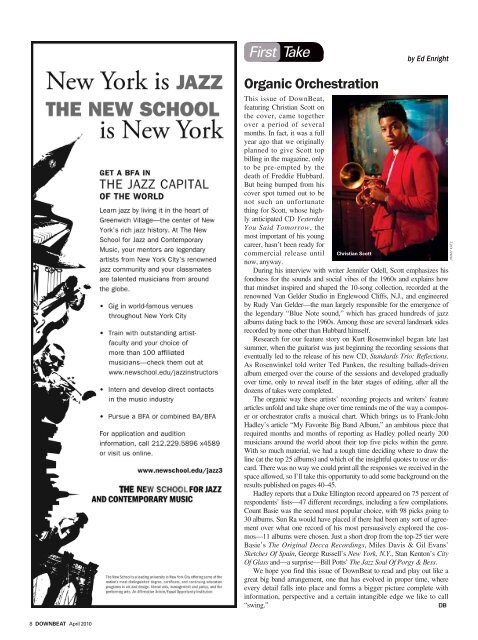Download - Downbeat
Download - Downbeat
Download - Downbeat
- TAGS
- download
- downbeat
- downbeat.com
You also want an ePaper? Increase the reach of your titles
YUMPU automatically turns print PDFs into web optimized ePapers that Google loves.
8 DOWNBEAT April 2010<br />
First Take<br />
Organic Orchestration<br />
by Ed Enright<br />
This issue of DownBeat,<br />
featuring Christian Scott on<br />
the cover, came together<br />
over a period of several<br />
months. In fact, it was a full<br />
year ago that we originally<br />
planned to give Scott top<br />
billing in the magazine, only<br />
to be pre-empted by the<br />
death of Freddie Hubbard.<br />
But being bumped from his<br />
cover spot turned out to be<br />
not such an unfortunate<br />
thing for Scott, whose highly<br />
anticipated CD Yesterday<br />
You Said Tomorrow, the<br />
most important of his young<br />
career, hasn’t been ready for<br />
commercial release until Christian Scott<br />
now, anyway.<br />
During his interview with writer Jennifer Odell, Scott emphasizes his<br />
fondness for the sounds and social vibes of the 1960s and explains how<br />
that mindset inspired and shaped the 10-song collection, recorded at the<br />
renowned Van Gelder Studio in Englewood Cliffs, N.J., and engineered<br />
by Rudy Van Gelder—the man largely responsible for the emergence of<br />
the legendary “Blue Note sound,” which has graced hundreds of jazz<br />
albums dating back to the 1960s. Among those are several landmark sides<br />
recorded by none other than Hubbard himself.<br />
Research for our feature story on Kurt Rosenwinkel began late last<br />
summer, when the guitarist was just beginning the recording sessions that<br />
eventually led to the release of his new CD, Standards Trio: Reflections.<br />
As Rosenwinkel told writer Ted Panken, the resulting ballads-driven<br />
album emerged over the course of the sessions and developed gradually<br />
over time, only to reveal itself in the later stages of editing, after all the<br />
dozens of takes were completed.<br />
The organic way these artists’ recording projects and writers’ feature<br />
articles unfold and take shape over time reminds me of the way a composer<br />
or orchestrator crafts a musical chart. Which brings us to Frank-John<br />
Hadley’s article “My Favorite Big Band Album,” an ambitous piece that<br />
required months and months of reporting as Hadley polled nearly 200<br />
musicians around the world about their top five picks within the genre.<br />
With so much material, we had a tough time deciding where to draw the<br />
line (at the top 25 albums) and which of the insightful quotes to use or discard.<br />
There was no way we could print all the responses we received in the<br />
space allowed, so I’ll take this opportunity to add some background on the<br />
results published on pages 40–45.<br />
Hadley reports that a Duke Ellington record appeared on 75 percent of<br />
respondents’ lists—47 different recordings, including a few compilations.<br />
Count Basie was the second most popular choice, with 98 picks going to<br />
30 albums. Sun Ra would have placed if there had been any sort of agreement<br />
over what one record of his most persuasively explored the cosmos—11<br />
albums were chosen. Just a short drop from the top-25 tier were<br />
Basie’s The Original Decca Recordings, Miles Davis & Gil Evans’<br />
Sketches Of Spain, George Russell’s New York, N.Y., Stan Kenton’s City<br />
Of Glass and—a surprise—Bill Potts’ The Jazz Soul Of Porgy & Bess.<br />
We hope you find this issue of DownBeat to read and play out like a<br />
great big band arrangement, one that has evolved in proper time, where<br />
every detail falls into place and forms a bigger picture complete with<br />
information, perspective and a certain intangible edge we like to call<br />
“swing.” DB<br />
JIMMY KATZ

















